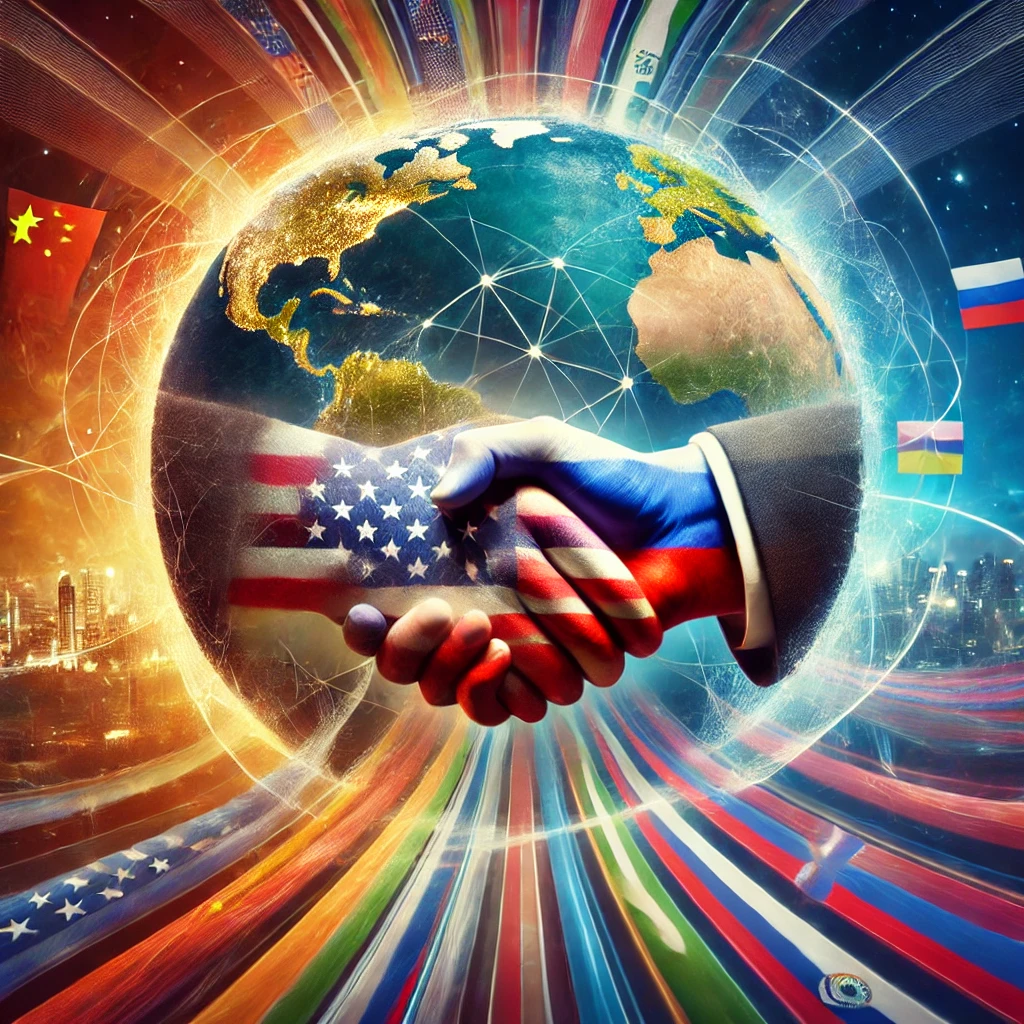Donald Trump’s foreign policy during his presidency (2017–2021) was marked by nationalist, transactional, and unilateral approaches. His “America First” doctrine often distanced the United States from multilateral institutions and international agreements. This paper explores how Trump’s foreign policy could be redirected toward a vision of global unity by drawing lessons from the European Union’s integration process. The EU, through economic and political integration, has demonstrated a model of overcoming historical divisions. This article assesses how a similar approach could be applied globally, particularly in fostering a cooperative framework between the United States, Russia, China, and India. By examining economic interdependence, diplomatic strategies, and institutional mechanisms, this paper outlines a path toward a unified, borderless “One World” that mirrors the EU’s foundational principles.
1. Introduction
The concept of global unity has been historically elusive, but the European Union (EU) has successfully integrated diverse nations under a cooperative framework (Schimmelfennig, 2018). This paper examines how Trump’s foreign policy, which emphasized nationalism and transactionalism, could be transformed by adopting lessons from the EU’s integration process. The goal is to evaluate a vision of a “One World” framework wherein economic and political cooperation lead to diminished geopolitical tensions, particularly among major powers such as the United States, Russia, China, and India.
2. Trump’s Foreign Policy and Its Challenges
Trump’s foreign policy prioritized bilateralism over multilateralism, frequently withdrawing from international agreements (e.g., the Paris Climate Accord, Trans-Pacific Partnership) (Dueck, 2020). His administration’s approach to diplomacy was often confrontational, characterized by trade wars with China and skepticism towards NATO (Feaver, 2021). While this strategy sought to maximize U.S. advantages, it contributed to increased global instability and deteriorating alliances.
3. The European Union as a Model of Integration
The EU’s evolution from the European Coal and Steel Community (ECSC) to the present-day supranational entity provides key lessons in achieving unity (Moravcsik, 2019). The process involved economic interdependence, diplomatic negotiations, and institutional consolidation, which reduced inter-state conflicts in Europe. A similar approach could foster stability among global superpowers by emphasizing shared economic interests and cooperative security arrangements.
4. Lessons from the European Union for Global Integration
4.1 Economic Integration and Interdependence The EU’s single market demonstrates how economic integration fosters peace and prosperity. The Maastricht Treaty (1993) further institutionalized economic cooperation (Hix & Høyland, 2021). The United States could promote similar economic frameworks with China, Russia, and India by supporting multilateral trade agreements and reducing protectionist policies. Such integration could mitigate geopolitical tensions by creating mutual economic dependencies.
4.2 Multilateral Governance and Institutions The EU’s institutions, such as the European Commission and the European Parliament, ensure collective decision-making (Laffan, 2022). A reoriented U.S. foreign policy could advocate for global governance structures that involve major powers in cooperative decision-making, potentially revitalizing institutions like the United Nations or creating new global economic and security bodies.
4.3 Conflict Resolution through Diplomacy The EU has employed diplomacy to resolve historical rivalries, such as the Franco-German reconciliation (Young, 2020). Applying this model, the U.S. could facilitate diplomatic dialogues between global rivals, particularly engaging in de-escalation efforts between China and India, and addressing Russian-Western tensions through multilateral forums.
5. Pathways to a Unified “One World” Framework
5.1 Strengthening Global Trade Agreements By endorsing multilateral trade agreements akin to the EU’s customs union, the U.S. could establish stronger economic ties with major global economies. This would involve re-engaging in the World Trade Organization (WTO) and championing new trade agreements that integrate major powers into a cooperative economic network.
5.2 Cooperative Security Mechanisms A unified world order requires robust security cooperation. NATO’s expansion has faced resistance from Russia, highlighting the need for an alternative framework that includes major global powers. Establishing a security cooperation mechanism involving the U.S., China, Russia, and India could serve as a confidence-building measure and prevent conflicts (Ikenberry, 2021).
5.3 Cultural and Educational Exchange Programs The Erasmus program has been instrumental in fostering European unity. Expanding educational and cultural exchange programs globally could create people-to-people connections that transcend political differences. A global exchange initiative involving the U.S., China, India, and Russia could contribute to long-term peacebuilding.
6. Conclusion
Trump’s foreign policy approach, while emphasizing national interest, often led to diplomatic estrangement and global uncertainty. By adopting lessons from the European Union’s integration process, a redirected U.S. foreign policy could facilitate a cooperative, unified world order. Economic integration, institutionalized multilateral governance, and diplomatic engagement present viable pathways toward achieving a “One World” framework. While challenges exist, the EU’s success provides a strong precedent for overcoming historical rivalries through cooperation and shared interests.
References
Dueck, C. (2020). Age of Iron: On Conservative Nationalism. Oxford University Press.
Feaver, P. D. (2021). Thanks for Your Service: The Causes and Consequences of Public Confidence in the US Military. Oxford University Press.
Hix, S., & Høyland, B. (2021). The Political System of the European Union. Palgrave Macmillan.
Ikenberry, G. J. (2021). A World Safe for Democracy: Liberal Internationalism and the Crises of Global Order. Yale University Press.
Laffan, B. (2022). European Union and the Logic of Integration. Routledge.
Moravcsik, A. (2019). The Choice for Europe: Social Purpose and State Power from Messina to Maastricht. Cornell University Press.
Schimmelfennig, F. (2018). European Integration Theory. Oxford University Press.
Young, J. W. (2020). Cold War Europe: The Politics of a Contested Continent. Bloomsbury Publishing.
Featured image: ChatGPT AI Image Creator

